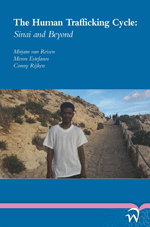The Human Trafficking Cycle: Sinai and Beyond
Published on Thu, 2013-12-05 14:49
The report "The Human Trafficking Cycle: Sinai and Beyond is based on the graphic testimonies of refugees from the Horn of Africa, the vast majority being Eritrean, who have been through the torture camps of Sinai. It is estimated that between 25,000 and 30,000 refugees have been held as hostages in Sinai, of whom many have died or disappeared. That total value of the entire Sinai Trafficking cycle is calculated to be of the order of 600 million USD. The Human Trafficking Cycle: Sinai and Beyond shows that for the survivors of Sinai the challenges do not end when they are released, but continue as most remain trapped in situations of insecurity and without the support they need to recover from the physical and psychological trauma of their experiences. The report "The Human Trafficking Cycle: Sinai and Beyond was presented to Cecilia Malmstroöm, EU Commissionere for Home Affairs, at a hearing in the European Parliament on December 4th. The hearing was hosted by Olle Schmidt MEP. The report, by Prof. Mirjam van Reisen, Meron Estefanos and Prof. Conny Rijken, focuses on the trafficking of refugees from the Horn of Africa who are targeted by criminal networks for extortion and exploitation. The report looks at the experiences of the refugees who have fled their countries looking for safety and security. Since the beginning of 2009 thousands of refugees from the Horn of Africa have been abducted and held for ransom in the Sinai desert. They include men, women, children and infants fleeing from desperate circumstances in Eritrea, Ethiopia and Sudan. An estimated 95% are from Eritrea. Smuggled across borders by middlemen, or kidnapped from refugee camps in Ethiopia and Sudan as well as their surrounding areas, they are held in inhumane conditions close to the Israeli borderr. They are tortured and abused to pressure their relatives, friends, and sympathetic strangers into paying enormous ransoms. Many of the refugees die in captivity or after their release, even after their ransom has been paid. Some simply disappear - killed while being held, shot by border guards, or from simply being lost in the desert. In 2012 the testimonies of refugees held in Sinai were published in Human Trafficking in the Sinai: Refugees between life and death. It gave them a voice, described the horrendous ordeals they suffer and sought to raise awareness of their desperate plight in the hands of criminal gangs. Refugees continue to be abducted and held in Sinai, with increasing numbers being taken from within their own countrIes. Even after release from captivity the future remains uncertain for the refugees. They risk further abduction, or detention by the authorities and potential re-patriation to their countries of origin. The recent tragedy off Lampedusa in which almost 400 asylum seekers died highlights the risks the refugees have to take in their bid to find relative safety. The report The Human Trafficking Cycle: Sinai and Beyond focuses on the journey to Sinai, the modus operandi in Sinai and the realities that refugees who survive meet beyond Sinai. Interviews with refugees held hostage in Sinai show that the realities they face remains as desperate as ever. Interviews with refugees who have been released and are now in Cairo, Tel Aviv and elsewhere give testimony to the ongoing hardships they face, their fears for the future and the trauma they are left with as a result of their experiences. Simultaneous launches of the report have been taking place in Lampedusa, Tel Aviv, Cairo, London and New York. A draft version of the report is now available: The Human Trafficking Cycle: Sinai and Beyond Source: EEPA. |
SUSCRIBE TO OUR NEWSLETTER



